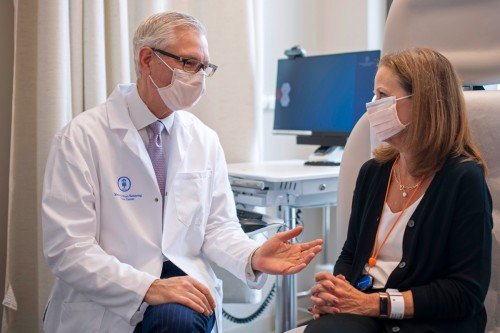
MSK scientists Charles Rudin and John Poirier are collaborating to develop new treatments for small cell lung cancer.
The statistics surrounding small cell lung cancer (SCLC) are grim. Nearly everyone diagnosed with the disease dies from it, and the average survival time for someone with metastatic disease is less than one year. New therapeutic options are badly needed, yet the disease has proved stubbornly resistant to treatment advances.
“We haven’t really had substantial change in the standard of care for this disease in 30 or 40 years,” says Charles Rudin, Chief of the Thoracic Oncology Service, Co-Director of the Druckenmiller Center for Lung Cancer Research, and holder of the Sylvia Hassenfeld Chair in Lung Cancer Research at Memorial Sloan Kettering.
But there are promising signs that the situation may be changing. A study published today in the journal Cancer Cell, led by senior authors Dr. Rudin and John Poirier, identifies a potential new way to combat the disease’s most wily attribute: its ability to rapidly develop resistance to chemotherapy.
“Although SCLC is incredibly chemosensitive initially, those responses are almost never durable and the disease comes roaring back,” explains Dr. Rudin. “When it does, it’s very resistant to treatment.”
The team has homed in on what they think is a switch that promotes resistance, and a class of drugs that can flip it back in the other direction.
Hunting for Differences
To answer the question of what accounts for the development of resistance, the team turned to mouse models of cancer. They implanted mice with patient-derived SCLC tumors to create so-called xenografts. Mice carrying chemosensitive xenografts were treated with a chemotherapy regimen similar to what patients receive in the clinic until the tumors developed resistance. The team then performed a side-by-side comparison of the tumor cells’ genetic makeup and gene expression profiles.
To their surprise, the main difference between the chemosensitive and chemoresistant tumors was not specific genetic mutations — changes in the DNA sequence — but rather the production of a particular protein called Schlafen 11.
Schlafen 11 is known to sensitize cancer cell lines to chemotherapy and is thought to play a role in how cancer cells respond to DNA damage — such as the kind that occurs when cells are treated with chemotherapy. When Schlafen 11 production goes down, cells can tolerate DNA damage more easily. This allows them to survive treatment with DNA-damaging chemotherapy, and therefore to become chemoresistant.
The production of Schlafen 11 is controlled by a process called histone methylation. In cells, DNA exists wrapped around proteins called histones that act as spools; how tightly wound and compact the DNA is can influence whether genes in that region are turned on or off. As the cancer cells are exposed to chemotherapy, they begin to accumulate a protein called EZH2, which transfers methyl groups to histones. This compacts the DNA and, in turn, silences genes. One of the genes turned off by this mechanism is Schlafen 11.
This is an example of an epigenetic change, one that alters the way genes are turned on or off in the cell — in this case, through the accessibility of the DNA — without changing the DNA sequence itself.
Though the researchers didn’t start out looking for an epigenetic mechanism to explain the development of chemoresistance, it fit well with the clinical picture.
“We know that in our models, and in the clinic, the emergence of acquired resistance can happen fairly quickly,” says Dr. Poirier. “So an epigenetic mechanism that converts already existing tumors to a more resistant phenotype made sense to us.”
The team confirmed the role of Schlafen 11 by showing that they could convert a chemoresistant tumor into a chemosensitive one by restoring the expression of this protein experimentally.
Drugs Already in the Pipeline
What most excites the researchers about this new finding is that there are drugs currently in clinical testing that block the action of EZH2. The drugs appear to be safe in people, so the researchers are eager to perform clinical trials. The plan is to test a combination of standard chemotherapy plus an EZH2 inhibitor, with the hope of forestalling — or even preventing — the development of chemoresistance in SCLC.
“It’s clear that an EZH2 inhibitor can reproducibly turn Schlafen 11 back on and that the magnitude of re-expression is strongly correlated with the degree to which these tumors are re-sensitized to chemotherapy,” says Dr. Poirier. “So we feel very confident in the pathway and the pharmacologic approach.”
The team is in the process of designing a phase I clinical trial.
Making Inroads
Dr. Rudin says the discovery represents the kind of collaborative, translational research he wanted his lab to pursue when he came to MSK three and a half years ago. “Dr. Poirier and I came together from Johns Hopkins with the idea of co-directing a laboratory because we think we have complementary strengths to offer,” he says — he as a clinical and translational investigator and Dr. Poirier as a basic scientist with expertise in molecular biology and bioinformatics. “We felt that this was a problem that we could both help to solve and then translate those insights to the clinic.”
Though not all SCLC tumors may develop resistance through this particular pathway, having a therapeutic strategy for those that do would be a big advance. Dr. Rudin likens it to the discovery of the EGFR mutation that drives a certain portion of non-small cell lung cancers — it presents a good therapeutic target, even if not everyone with NSCLC has this mutation.
“We’re really excited about this,” he says. “If this holds up in the clinic, we think this approach could result in a breakthrough for small cell lung cancer patients. It has certainly been a long time coming.”





